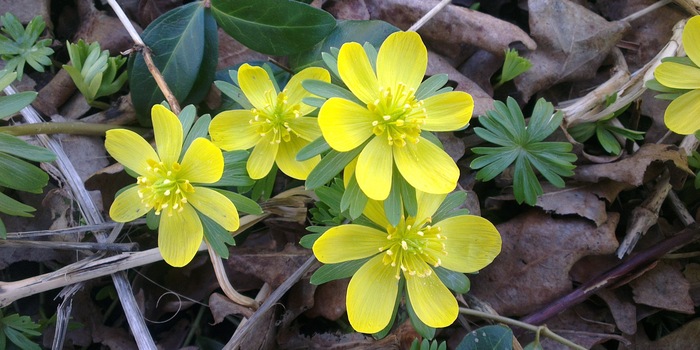
The gardening year at a glance
There's a lot to do in the garden every month. To ensure that you sow the desired plant and vegetable species at the right time, it is worth planning the coming gardening season in January.
With the first snow, the gardening year is finally coming to an end. The garden has been winterised for a long time. All the plants that needed winter protection have been well covered with winter fleece. The non-hardy potted plants have already been put away in the cool cellar and the more sensitive plants have been placed in a sheltered spot near the house. This way, you can quickly protect them with a fleece if the temperature drops below zero. The tools are all clean and oiled and stored in the cellar.
Although there's not much going on in the garden at the moment apart from shovelling snow, now is the best time to plan your future garden projects.
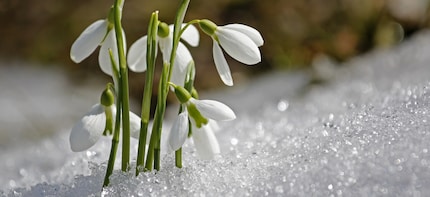
First blooming garden messengers
Garden planning in January
It is best to draw your garden with the garden beds on a sheet of paper and label the individual garden beds with the vegetables you are planning for the coming gardening season.
It is important that you do not plant heavy eaters such as maize or cabbage in the same location as last year, as this leaches the soil too much. There is also a risk that the crop will become more susceptible to disease, as existing pathogens can survive in the soil and may be transmitted in the spring. I therefore recommend that you always plan an alternating crop sequence. For this reason, it makes sense to create a garden plan.

Early garden planning in January facilitates the cultivation sequence in 2018
Tomatoes, on the other hand, love it when they are always in the same place. Just make sure that you generously add new soil and compost to the bed in spring - or even better, in autumn. Tomato plants are very demanding and need humus-rich soil.
First sowing in February
In February, you can sow the first annual flowers in a heated greenhouse. These are, for example:
- Ageratum (liver balsam)
- Antirrhinum (snapdragon)
- Dianthus (carnation)
- Impatiens (sweet pea)
- Lobelia (lobelia)
- Petunia (petunia)
- Thunbergia (black-eyed Susan)
- Verbena (verbena)
You can sow the following in a cold frame or foil tunnel:
- Kohlrabi
- Early radishes
- Head lettuce
- Picking lettuce
- White and blue cabbage
- Broccoli
- Cauliflower
- Mangold
Once the seeds have germinated, you should wait to prick out the seedlings until cotyledons and a first pair of leaves have developed. Now you can "separate" the young seedlings into a larger sowing tray. This process is also known as "pricking out". Pricking out is done so that the seedlings have enough space to grow for approx. 2-3 weeks.
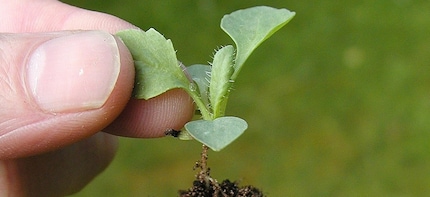
Pricking out the seedling with cotyledon and first pair of leaves
Sow directly outdoors in March
You can sow the first vegetables directly outdoors in March. To do this, loosen the bed beforehand and hoe it deeply with a garden weeder. If there are any weeds, clear them away. Then work compost and a complete organic garden fertiliser into the soil and sow the vegetable seeds. As a rule of thumb, cover the seeds to the thickness of the seed (with the exception of light sprouts).
Sow the first suitable vegetable seeds outdoors:
- Seed peas
- Cracker peas
- Peas
- Spinach
- Early carrots
- Cut lettuce
- Radishes
- Winter purslane
- Shallots, planted
- Garlic, planted
- Onion sets, planted
- Black roots
- May turnips
- Onions
The earlier you sow snap peas and snow peas, the better and more productive they will develop later in the crop. In the event of frost, you should cover the freshly sown seeds with garden fleece. If you sow directly into a cold frame, you can speed up the time to harvest.
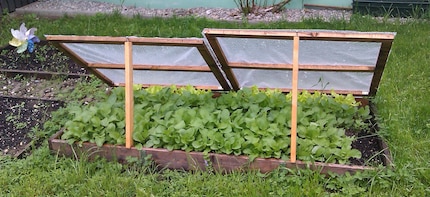
Cut lettuce and radishes are very suitable for growing in cold frames
Gardening in April
Depending on the weather, you can now do a lot of work in the garden:
- Plant out hardened vegetable seedlings
- Divide and replant perennials if necessary
- Add compost
- Feed and fertilise particularly hungry perennials such as peonies and delphiniums with compost
- Divide and replant perennial herbs
- Mow the lawn as soon as the forsythia flowers
- Sow a new lawn
- Repair holes in the existing lawn
- Weed the lawn
- Sowing and planting out spice and tea herbs
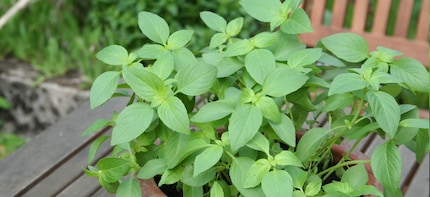
The planting month of May
May is the gardening month par excellence. Now you can also sow or plant the remaining more cold-sensitive flowers and plants in their final destination. These include, for example:
- Basil
- Peppers
- Aubergine
- Melon
- Bush bean
- Nasturtium
With the warmer temperatures, you can now take your potted plants out of their winter quarters. Cut them back as required, fertilise them and then carefully acclimatise them to their new location.
Do you like romance and are you looking for a beautiful plant for a shady location? Then the hydrangea is just the plant for you. With its many large flowers, it has become a real trendsetter in recent years and is available in many different shades of colour.
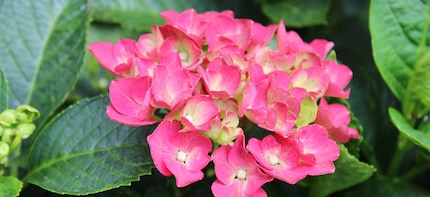
Hydrangeas like it cool and shady
Summer months June / July / August
The warmer the temperatures, the more time and watering effort you will need. You may have to water several times a day. Depending on the amount of work involved, it may be worth installing an automatic watering system.
In order to keep the lawn nice and green, it is now also important that your lawn is mowed and watered regularly.

Autumn months September / October / November
In the autumn months, there is a little more to do in the garden than in summer. There is a lot to harvest, beds to clear and pruning work to be done on perennials and shrubs. Later in the autumn there is a lot of dead leaves to rake up and take away or compost. Heat-loving potted plants should be returned to their winter quarters by the beginning of November at the latest.
As long as the ground is not frozen, you can plant flower bulbs for next spring so that they can still grow. The same applies to planting perennials, shrubs and fruit trees.
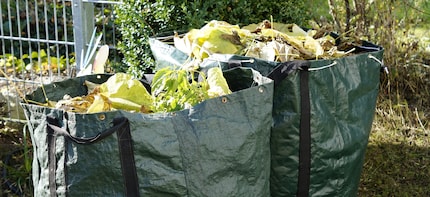
Autumn work in the garden
Winter month of December
December is a quiet month in the gardening year. The garden goes dormant and life moves indoors into the warmth of the parlour. Perhaps you now have the muse and desire to create an Advent plant decoration, an Advent wreath or winter door decorations
.
Or you can simply review the gardening year, enjoy the pre-Christmas Advent season with a warm punch and, like me, start planning new gardening projects for next year.
I discovered my love for gardening very early on and later turned my passion into my profession. For a few years now, I’ve been regularly writing blog posts and publishing articles in the HomeGardening section of myPfadFinder.com. This is where I give readers tips and tricks on gardens and balconies and present my latest gardening videos.
Find out more about me here: <a href="http://www.andreas-homegardening.com/" target="_blank">www.andreas-homegardening.com</a>
Interesting facts about products, behind-the-scenes looks at manufacturers and deep-dives on interesting people.
Show all